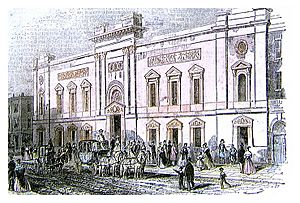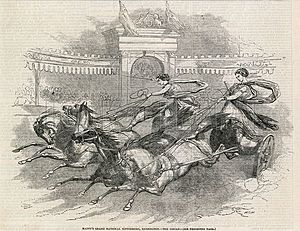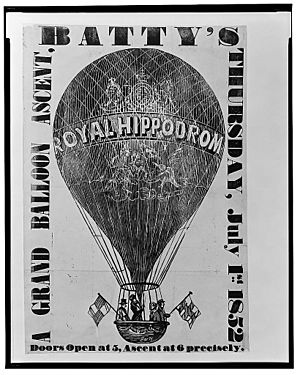William Batty facts for kids
Quick facts for kids
William Batty
|
|
|---|---|
| Born | 1801 |
| Died | 1868 (aged 66–67) |
| Occupation | Equestrian performer, circus proprietor, and longtime operator |
William Batty (born 1801, died 1868) was a famous horse rider and circus owner. He also ran Astley's Amphitheatre in London for many years. He was one of the most successful circus owners in Victorian England (that's the time when Queen Victoria ruled).
Batty helped many famous circus stars get their start. These included Pablo Fanque, a talented performer who later owned his own circus. You might know Pablo Fanque from a Beatles song! Another star Batty helped was W.F. Wallett, who was one of the most famous clowns of his time.
Even though it only ran for two years, Batty's most remembered creation is probably Batty's Grand National Hippodrome. This was a huge outdoor arena he built in 1851 in Kensington Gardens, London. He hoped it would attract visitors from the Crystal Palace Exhibition nearby.
Contents
Batty's Early Circus Days
William Batty was already a skilled horse rider by 1828. By 1836, he had started his very own circus. That year, Pablo Fanque was performing with him in Nottingham. He was known as a "rope dancer."
Over the next few years, Batty's circus traveled all around the United Kingdom. In 1838, they performed in Newcastle and Edinburgh. By 1840, they were in Portsmouth and Southampton.
Rebuilding Astley's Amphitheatre
Astley's Amphitheatre was a famous circus venue in London. It sadly caught fire for the third time. When this happened, Batty was in Dublin. He quickly took the next boat to London to plan for its rebuilding.
Batty put W.F. Wallett in charge of his circus in Dublin. Meanwhile, Batty planned a temporary circus in Oxford until Astley's could be rebuilt. While Batty was in Oxford in 1841, Pablo Fanque decided to leave and start his own circus. Wallett also joined Fanque. Even so, Batty and Fanque would sometimes work together again over the next twenty years.
Running Astley's Amphitheatre
Batty managed Astley's Amphitheatre from 1842 to 1853. All the biggest circus acts of the time performed there. This included Pablo Fanque, who performed for twelve nights in March 1847. In 1853, Batty leased the building to William Cooke. Cooke then ran Astley's until 1860.
Batty's Grand National Hippodrome
While managing Astley's, Batty bought land in Kensington Gardens, London in late 1850. He wanted to build a large outdoor arena for shows and horse events. Batty chose this spot because it was close to the Crystal Palace Exhibition. He hoped to attract many visitors from there.
The famous architect George Ledwell Taylor designed the building. It was made of iron and wood by the company Haward and Nixon. The arena had an eight-row grandstand that could seat 14,000 people. It surrounded a large oval space.
Hippodrome Shows and Challenges
This new arena was called Batty's Grand National Hippodrome, or simply Batty's Hippodrome. It opened in May 1851 with a French circus group from Paris. Besides horse shows, Batty also put on camel and ostrich races. He even had hot air balloon ascents!
Batty's Hippodrome opened for a second season in 1852. During this season, a balloon launch went wrong. The balloon avoided crashing into the Crystal Palace Exhibition but hit a nearby mansion. This caused serious injuries to the people inside the balloon.
After the 1852 season, Batty stopped putting on shows at the Hippodrome. The arena was then used as a riding track for several years. Eventually, it was taken down. Today, there is no sign left of Batty's Hippodrome.
Batty's Later Life and Legacy
When William Batty died in 1868, he was said to be very wealthy. He is buried in Kensal Green Cemetery in London.
In recent times, an American ringmaster named Noah Mickens uses Batty's name as his stage name. Noah Mickens runs a circus called Wanderlust Circus in Oregon. Before that, his first circus was called Batty's Hippodrome. Both are ways he honors William Batty.
Images for kids







